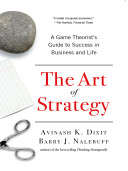

Game theory is the mathematical study of strategic interactions among rational decision-makers. The book emphasizes the importance of understanding game theory as a tool for analyzing competitive situations. It provides frameworks for anticipating the actions of competitors and making informed decisions. By understanding the basic principles of game theory, individuals can better navigate complex scenarios, whether in business, politics, or personal relationships. The book introduces concepts such as Nash Equilibrium, dominant strategies, and zero-sum games, illustrating how these concepts can be applied in real-world situations. The authors use engaging examples to show how strategic thinking can lead to better outcomes and how miscalculations can result in failure. The chapter encourages readers to think critically about their choices and to consider the potential responses of others, highlighting the interdependence of decisions in a competitive environment.
Continue readingCommitment plays a crucial role in strategic decision-making. The book discusses how making credible commitments can influence the behavior of competitors and allies. By committing to a particular course of action, individuals can shape the expectations of others, thereby gaining a strategic advantage. The authors provide examples from various fields, including business and international relations, to illustrate how commitments can deter competitors from taking aggressive actions. The concept of 'commitment devices' is introduced, which are mechanisms that help individuals stick to their strategic plans. The chapter emphasizes the need for careful consideration of the timing and nature of commitments, as well as the potential costs associated with them. Understanding how to leverage commitment can lead to more favorable outcomes in negotiations and competitive scenarios.
Continue readingThe book outlines the concept of strategic moves, which are actions taken to influence the behavior of others. It discusses various types of strategic moves, including signaling, bluffing, and preemptive actions. The authors explain how these moves can create advantages in competitive situations and how they can be countered by opponents. The importance of anticipating the reactions of others is emphasized, as well as the need to remain flexible in one's strategy. The chapter provides case studies that demonstrate successful strategic moves and the consequences of poor decision-making. By understanding the dynamics of strategic moves and countermoves, readers can enhance their ability to navigate complex interactions and improve their strategic thinking skills.
Continue readingInformation asymmetry is a central theme in strategic decision-making. The book explores how access to information can create advantages in competitive situations. It discusses the importance of gathering intelligence about competitors and understanding the market landscape. The authors highlight the role of signaling and screening in managing information asymmetry, illustrating how individuals can convey or extract information to their benefit. The chapter also addresses the ethical implications of information manipulation and the potential consequences of misinformation. By recognizing the value of information and developing strategies to manage it, readers can improve their decision-making processes and enhance their competitive edge.
Continue readingReputation is a powerful strategic asset that can influence interactions and outcomes. The book discusses how reputation affects the behavior of competitors and allies, shaping the strategic landscape. It emphasizes the importance of maintaining a positive reputation and the long-term benefits it can provide. The authors provide examples of how reputation can serve as a commitment device, deterring competitors from aggressive actions. The chapter also addresses the challenges of managing reputation in the digital age, where information spreads rapidly and can be difficult to control. By understanding the dynamics of reputation and its impact on strategic interactions, readers can develop strategies to protect and enhance their reputational capital.
Continue readingNegotiation is a critical aspect of strategic decision-making, and the book delves into the strategies and tactics that can enhance negotiation outcomes. It discusses the importance of preparation, understanding the interests of all parties, and the role of creativity in finding mutually beneficial solutions. The authors emphasize the need for effective communication and the ability to read the dynamics of the negotiation process. The chapter provides practical tips for negotiating successfully, including the importance of building rapport and trust. By applying the principles of strategic negotiation, readers can improve their ability to achieve favorable outcomes in various contexts, from business deals to personal relationships.
Continue readingFailure is an inevitable part of strategic decision-making, and the book emphasizes the importance of learning from mistakes. The authors discuss how failures can provide valuable insights into the dynamics of strategy and help individuals refine their approaches. They encourage readers to adopt a growth mindset, viewing failures as opportunities for improvement rather than setbacks. The chapter provides examples of successful individuals and organizations that have embraced failure as a learning tool. By understanding the lessons that can be gleaned from failure, readers can enhance their resilience and adaptability in the face of challenges.
Continue reading